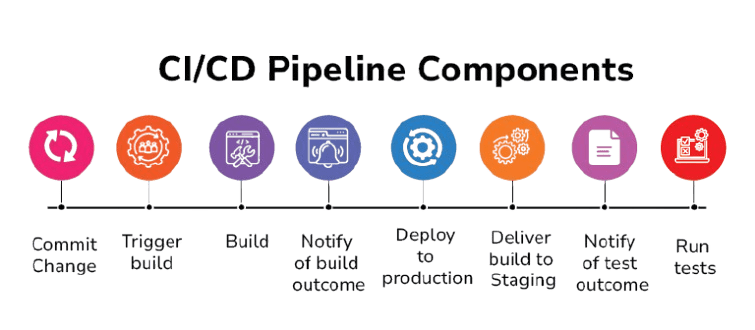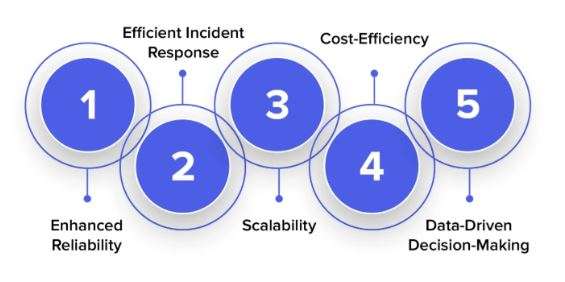
- Introduction: Understanding SRE and DevOps
- What is DevOps?
- What is SRE?
- Core Differences Between SRE and DevOps
- How SRE and DevOps Relate to Each Other
- SRE vs DevOps: Which One is Right for Your Organization?
- Benefits of Implementing SRE or DevOps
- Challenges in Implementing SRE or DevOps
- Real-World Examples of SRE and DevOps in Action
- Conclusion
Introduction: Understanding SRE and DevOps
In today’s fast-paced world, where software applications and IT infrastructure are the backbone of most businesses, organizations must manage their services effectively and efficiently to maintain competitive advantages. Two approaches have gained significant traction in recent years—Site Reliability Engineering (SRE) and DevOps. While Devops Training and related concepts are often discussed together, it’s crucial to understand their distinctions, overlaps, and benefits before deciding which is the best fit for your organization. In this blog post, we’ll explore the essential differences between SRE and DevOps, how they complement one another, and which approach could best suit your organization’s specific needs.
What is DevOps?
DevOps is a cultural and operational model that emphasizes collaboration between software developers and IT operations teams to increase the speed and quality of software delivery. DevOps integrates development (Dev) and operations (Ops) to break down traditional silos and foster collaboration. DevOps, including Azure Devops, brings together key areas like continuous integration (CI), continuous delivery (CD), automation, infrastructure as code, and monitoring to ensure smoother operations. It’s all about ensuring teams can work together more seamlessly, innovate faster, and resolve issues quicker.
Key Principles
- Collaboration and Communication: Breaking down silos between development, operations, and other teams.
- Automation: Automating repetitive tasks, such as testing, builds, and deployments, to reduce human error and improve efficiency.
- Continuous Integration and Delivery (CI/CD): Ensuring code is constantly integrated into the main branch and can be delivered frequently with automated processes.
- Monitoring and Feedback: Continuously monitor the systems and provide feedback to improve software and operations.
- Rapid Iteration: Emphasizing agility and continuous improvement.
Eager to Acquire Your Devops Certification? View The Devops Training Offered By ACTE Right Now!
What is SRE?
Site Reliability Engineering (SRE) is a discipline that incorporates aspects of software engineering and applies them to infrastructure and operations problems. Originating at Google, SRE builds and maintains scalable and reliable software systems. SRE aims to apply engineering principles to operations tasks, leveraging automation and monitoring and focusing on Reliability to manage large-scale systems. The approach takes the practices of DevOps and goes deeper into measuring and defining Reliability through Service Level Objectives (SLOs), Service Level Indicators (SLIs), Service Level Agreements (SLAs), and Load balancing .
Key Principles
- Reliability at Scale: Focused on ensuring reliable and resilient services under high traffic.
- SLIs, SLOs, and SLAs: Defining measurable metrics around availability, error rates, and latency to determine system reliability.
- Emphasizing Automation: Unlike DevOps, SRE focuses on automating processes and removing manual work.
- Blurring the Lines Between Development and Operations: SREs work closely with developers but with a heavier focus on Reliability and uptime.
- Toil Reduction: SRE aims to reduce manual intervention and repetitive work (toil), making systems more efficient.

Core Differences Between SRE and DevOps
While SRE and DevOps share common goals, they differ in approach.
Focus: DevOps emphasizes collaboration between development and operations to improve software delivery, while SRE prioritizes system reliability and uptime.
Key Metrics: DevOps measures success through delivery speed and CI/CD efficiency, whereas SRE focuses on reliability metrics like SLIs, SLOs, and SLAs.
Team Roles: DevOps teams consist of engineers and cross-functional teams, while SRE teams include site reliability engineers specializing in uptime and performance.
Automation: DevOps automates for speed and efficiency using Devops lifestyle tools, while SRE automates for reliability and resilience, reducing manual interventions.
Risk Tolerance: DevOps embraces some risk for faster releases, while SRE minimizes risk, using error budgets to balance innovation with stability.
Measuring Success: DevOps values fast delivery and iteration, while SRE measures success through uptime, reliability, and performance consistency.
Both approaches complement each other—DevOps enhances agility, while SRE ensures long-term stability. Many organizations adopt a hybrid model for the best results.
How SRE and DevOps Relate to Each Other
Tools and Technologies for CI/CD
Though SRE (Site Reliability Engineering) and DevOps have distinct focuses, they share a common goal: improving the software development lifecycle. DevOps primarily aims to accelerate software delivery and eliminate the barriers between development and operations teams. It fosters a culture of collaboration, continuous integration, and agile practices to enhance speed and efficiency. On the other hand, SRE builds upon DevOps and Devops Training by emphasizing system reliability and performance more strongly. While DevOps focuses on increasing the frequency of releases and reducing bottlenecks, SRE refines these practices by prioritizing service reliability and setting concrete, measurable goals like Service Level Indicators (SLIs), Service Level Objectives (SLOs), and Service Level Agreements (SLAs). These metrics guide decision-making and help teams ensure systems meet desired performance standards, balancing Reliability with speed. Both methodologies advocate for cross-functional collaboration, but SRE is more prescriptive, offering a framework for maintaining Reliability. In contrast, DevOps encourages a broader cultural shift towards agile, iterative development and operations practices.
Ready to Earn Your Devops Certificate? View The Devops Course Offered By ACTE Right Now!
SRE vs DevOps: Which One is Right for Your Organization?
- Scale and Complexity of Infrastructure: SRE may be more appropriate for large-scale systems that need to maintain high levels of availability. If you’re running complex systems with many dependencies and need to focus strongly on uptime, SRE’s reliability-first approach will be invaluable.
- Speed vs. Reliability: DevOps is a better fit if your organization is primarily focused on speed and agile software delivery. DevOps emphasizes CI/CD, faster release cycles, and collaboration to deliver features quickly.
- Team Structure:DevOps requires cross-functional teams to work together seamlessly. If your organization lacks collaboration or has siloed departments, implementing DevOps might be a necessary first step. Improve code quality with CI/CD automation to ensure continuous testing, integration, and deployment.
- Maturity Level: If your teams are already relatively mature and the systems are large, implementing SRE can build upon the solid DevOps foundation and offer more advanced monitoring and reliability measures.
- Tech Companies: Tech companies that manage large-scale systems and services, like cloud platforms, benefit from SRE’s focus on scaling Reliability. Google, for instance, pioneered the SRE model in its large-scale, cloud-native systems.
- Startups and Agile Organizations: Startups or smaller organizations prioritizing rapid feature delivery may find DevOps more beneficial due to its emphasis on quick iterations and agility.
- Enterprise Businesses: Larger, more complex organizations might adopt a hybrid approach, where DevOps lays the groundwork for agility and speed while SRE ensures systems remain reliable at scale.

Benefits of Implementing SRE or DevOps
Improved Reliability:By defining SLOs and SLIs, SRE ensures critical systems meet their reliability targets.
Enhanced Scalability: SRE emphasizes systems that can scale while maintaining Reliability.
Proactive Monitoring: Focuses on detecting issues before they affect users, improving the user experience.
Toil Reduction: By automating repetitive tasks, SREs focus on more meaningful work, reducing burnout.
Faster Delivery: DevOps practices enable quicker release cycles and faster time to market.
Improved Collaboration: Breaking down silos between development and operations fosters better communication and faster resolution of issues.
Automation of Repetitive Tasks: Automates build, test, and deployment processes, reducing manual errors and increasing productivity.
Agility: Emphasizes the ability to adapt to changes in market demands and customer needs quickly.
Thinking About Earning a Master’s Degree in Devops? Enroll For Devops Masters Program by Microsoft Today!
Challenges in Implementing SRE or DevOps
While SRE and DevOps offer significant advantages, organizations may face challenges when adopting these methodologies. Cultural Shift Both SRE and DevOps require breaking down traditional silos between development and operations teams. Shifting to a collaborative culture can be difficult, especially in organizations with rigid structures. Implementing SRE requires expertise in software engineering, reliability principles, and automation. Similarly, DevOps demands skills in CI/CD, infrastructure as code, and cloud platforms. Organizations may need to invest in upskilling or hiring specialized talent. Adopting automation, monitoring, and CI/CD pipelines requires integrating multiple tools. Managing and maintaining these tools can be complex and may introduce operational overhead. Organizations often struggle to balance the rapid delivery focus of DevOps with the reliability-driven approach of SRE. Striking the right balance requires careful planning and iteration. Teams accustomed to traditional IT operations may resist new workflows, automation, and accountability shifts that SRE and DevOps introduce. Strong leadership and clear communication are necessary to drive adoption of DevOps practices. In addition to these, Key artifacts in devops such as CI/CD pipelines, Infrastructure as Code (IaC), automated testing frameworks, and monitoring dashboards—play a crucial role in streamlining development and operations.
Real-World Examples of SRE and DevOps in Action
- Many leading tech companies have successfully implemented SRE or DevOps to improve efficiency, reliability, and scalability. Google pioneered SRE to ensure high availability and reliability across its services like Search, Gmail, and YouTube.
- By implementing SLIs and SLOs, Google maintains strict reliability goals while balancing innovation and risk. Netflix relies on DevOps practices to deliver seamless streaming experiences.
- By automating deployments, using chaos engineering to test system resilience, and leveraging cloud-native technologies, Netflix ensures continuous delivery with minimal downtime. Amazon follows a mix of DevOps and SRE principles.
- AWS services prioritize high availability, leveraging automation and monitoring (SRE), while their e-commerce platform benefits from agile DevOps practices to iterate quickly and deliver new features.
- Uber uses SRE to manage the reliability of its ride-hailing platform. They employ observability tools, incident management strategies, and automated failover mechanisms to handle peak traffic conditions efficiently.
- Spotify follows DevOps best practices to enhance its continuous integration and deployment workflows. With small, autonomous teams deploying code frequently, they ensure rapid feature development without compromising stability.
- These examples highlight how companies tailor SRE or DevOps approaches to meet their operational needs, proving that both methodologies can drive success when implemented strategically.
Getting Ready for a Devops Job Interview? Check Out Our Blog on Devops Interview Questions & Answer
Conclusion
SRE and DevOps offer substantial benefits, but the right approach depends on your organization’s needs. DevOps might be the ideal approach if you’re a startup or an organization that prioritizes speed and agility. On the other hand, if your organization manages large-scale systems and needs to ensure maximum Reliability, SRE might be the best fit. A hybrid approach incorporating both methodologies can yield the best results for many organizations. By blending the agile speed of DevOps and Devops Training with the reliability-focused practices of SRE, companies can improve both the speed and the quality of their software delivery, ensuring they meet user expectations and stay competitive in the ever-changing digital landscape. Understanding your organization’s unique goals, team dynamics, and infrastructure scale is key. Once you have that in mind, you’ll be in a much better position to choose the right approach to optimize your operations and development processes effectively.





